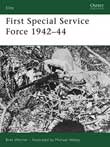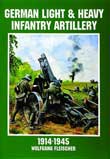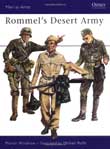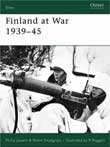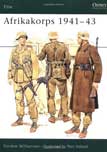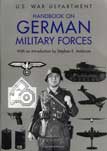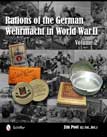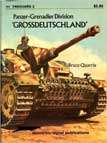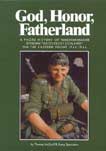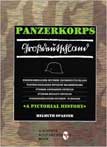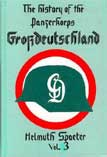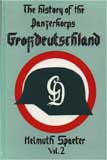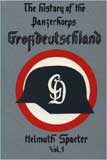

Osprey's examination of the First Special Service Force of the second half of World War II (1939-1945). This famous unit was formed with three battalions in July 1942, for special operations in occupied Norway, from handpicked US and Canadian volunteers who were trained in parachute, amphibious, ski, mountain and demolition operations and other 'Special Forces' skills. Their training base was Fort Harrison, Montana. In the event the Force first saw combat in Italy. There they distinguished themselves, at heavy cost, in the battles of La Difensa (Dec 1943), Mte Majo (Jan 1944), on the Anzio beachhead (Feb - May 1944) and in the race to Rome, which they actually liberated. Their uniforms, clothing and weaponry had many unique features reflecting their bi-national composition and specialist skills.
The FSSF fought with a ferocious skill which earned them a fearsome reputation. At Anzio, although at only half strength, they successfully held at least a quarter of the entire beachhead and were the spearhead of the final breakout towards Rome. Famed for their night-time fighting ability, the Germans named them "Die Schwartze Teuflen" the Black Devils (they blacked their faces with boot polish). However, after taking part in the South of France campaign in Aug - Nov 1944 the Force was disbanded, survivors passing to other units. 1,800 men at full strength, they had accounted for 12,000 enemy casualties, taken 7,000 prisoners and experienced a 600% attrition rate.
Reviewer: Mal Wright from Adelaide, South Australia.
This booklet, by Wolfgang Fleischer, is a bit misleading as the title leads one to expect more coverage of WW1. Instead it skips over the 1914-18 period and seems to use it more as an introduction to WW2. That is a shame as even though it does not mention many WW1 guns, those it does skip across are interesting weapons. After a couple of pages of fairly vague text on WW1 it goes into WW2 infantry guns in considerably more detail. Once again it is often tempting, but not very fulfilling. However the photographic coverage of WW2 Infantry guns is quite extensive. It should prove helpful to those wanting to model some of the weapons in detail and at the price is therefore a bargain. As a serious work on the subject, it is however lacking in technical data and comparisons. I give this booklet 3 stars for WW2 and would give it half a star for WW1. It is worth adding to your collection and won't break your budget.
Interest in the momentous events of World War ll seems never to decrease, despite the fact that the 1939-45 period is beyond the memory of a great number of those who now study it. The greatest fascination is almost always reserved for the arms and achievements of the country that was instrumental in starting the war and ultimately, losing it.
The emphasis of the book is on what was and is most commonly seen - for example, through contemporary newsreels, hence rarely seen or less important uniform variations are not included. A listing of key items is given in a series of appendices. This is a detailed handbook to the German army of the period, its history, its organization, its uniform and its equipment.
The desert war produced commanders of dash and originality on both sides and the memory of the German commanding general, Erwin Rommel, has endured as the epitome of skill, daring and soldierly integrity. His victories in World War II were brilliant until he was bested by poor health, lack of reinforcements and an opposing commander who was his equal. The contribution of his various troops is detailed in a full order of battle which includes his veteran Afrika Korps and Italian allies, and their uniforms are shown in full color artwork.
Osprey's examination of Finland's involvement in World War II (1939-1945). Finland's fight to defend her independence earned this tiny nation of just 3 million people a distinct place in history. Invaded by Stalin before World War II, Finland held out for months and inflicted huge losses on the invaders, but she was eventually crushed by the weight of Soviet numbers. When Germany invaded the USSR in 1941 the Finns fought alongside the Wehrmacht on the northern Russian Front, with great skill and courage in an attempt to regain their lost territories. When the German armies were forced to retreat in 1944, Finland managed to conclude a separate peace with the USSR – uniquely, without being forced to accept renewed Russian occupation. This book details the organisation, uniforms and equipment of this remarkable force.
Osprey's study of the German Afrikakorps of World War II (1939-1945). The campaign in North Africa between September 1940 and May 1943 holds not only an enduring fascination for postwar generations; but also a perhaps unique degree of nostalgia for some surviving participants. The campaign was no less costly in terms of human lives and material than many others; but regret at the cost is accompanied by positive memories in the minds of many veterans. This is not to suggest that the dead have been forgotten; but an almost mystical bond nevertheless exists, even between former enemies, amongst veterans of the desert campaign. Gordon Williamson examines the history, organisation and uniforms of Rommel's Afrikakorps.
An exhaustive, clearly written, illustrated compilation of information about the German war machine from 1939 to 1945 covers military command structure, unit organization, field tactics, fortification, weapons and other equipment, uniforms and insignia.
One of the old stand-bys on details of the German Armed Forces. Contains information not only on the various types of equipment in use, but also information on training, supply, organization, etc.
This new book is the follow-on work to the author s well-received Rations of the German Wehrmacht in World War II. Aided by the discovery of a large body of wartime British Government intelligence reports this volume helps to further unravel the mysteries of the wartime German food industry. Utilizing the successful formula of the first book this volume addresses the Special/Emergency rations of the German military, the feeding of the German soldier during offensive operations, as well as offering a comparison of the German and U.S. Army ration organizations. Lavishly illustrated with photographs, charts, wartime advertisements, and other educational aids this book is a must for every serious collector and historian of the German military in World War II.
A "quickie" book that will give the reader a overview of Großdeutschland. Probably out of print.
Panzergrenadier Division "Grossdeutschland" was one of Germany's most celebrated military formations of the Second World War. Formed in 1942 by the expansion of Infantry Regiment (motorized) "Grossdeutschland," the new division quickly earned its reputation on the Eastern Front of being the elite of the German Army. Twice the size of most other divisions, it was an immensely powerful and hard-hitting mechanized formation that cut a large swath through the Red Army, whether in the attack or on the defense. Its carefully selected officer and non-commissioned officer corps ensured that no matter what the odds, the division would always give a good account of itself in battle and would possess an esprit de corps enjoyed by few other comparable divisions, including those of the Waffen-SS.
The thousands of volunteers from every land and province in Germany who fought and died while serving in the ranks of Panzergrenadier Division "Grossdeutschland" represented a cross-section of German society, a radical departure from the manner in which most German divisions of the era were created. Now for the first time, the faces of these men, at rest and in battle, can be seen through the images gleaned from hundreds of photographs taken by the division's war correspondents or Kriegsberichter.
This outstanding selection of photographs, which until recently remained unseen for decades in a European archive, have been recovered and painstakingly researched by authors Remy Spezzano and Thomas McGuirl. Together with the assistance of the division's Veterans' association, they identified hundreds of men, living and dead, as well as dozens of combat vehicles, items of equipment, and specific engagements the division took part in from April 1942 to September 1944. Accompanied by a detailed narrative that ties each of the photos within the context of the war on the Eastern Front, "God, Honor, Fatherland" represents a milestone in the study of the war in the East and shows the face of the German soldier as he has never been shown before.
German language edition. A companion to the above book, this volume is chock full o' GD photos. It is also available in English, but I know not where. Photo history of one of the most elite fighting units in WWII by one of its former members. Includes listing of Knights Cross Winners.
The absolute "last-word" on GD. Translated from the German, this book has every thing there is about GD and its offspring units. Hard cover, small format (6" x 9"), 507 pages, 30+ maps and diagrams. This is the third and final volume of the text history of this elite formation. Sections include: The creation of Panzer-Korps "Großdeutschland"; the complete history of the Brandenburgers as a commando unit; the history of Panzer-Grenadier-Division "Brandenburg"; the final fighting of both "Großdeutschland" and "Brandenburg"; the activation of additional "Großdeutschland" formations in the final, desperate fighting; the "Führer" Divisions on the Eastern Front; the Panzer-Grenadier-Division "Kurmark". Each section is filled with detailed, first-hand accounts from the participants. The author is Knight's Cross recipient Helmut Spaeter.
The absolute "last-word" on GD. Translated from the German, this book has every thing there is about GD and its offspring units. Hard cover, small format (6" x 9"), 494 pages, 20 maps. Volume 2 covers the "GD" from late 1942 until early 1945. It includes extensive details on affiliated units such as Kurmark, Brandenburg and the Führer-Begleit-Brigade. Lots of first-hand descriptions and small-unit actions.
The absolute "last-word" on GD. Translated from the German, this book has every thing there is about GD and its offspring units. Hard cover, small format (6" x 9"), 479 pages, many maps and orders of battle. The first volume of a 3-volume set covers the "GD" (Greater Germany) from its inception as a "Wach"-Regiment in 1921 through its evolution into an infantry regiment. Covered are the unit's first action in France in 1940 and its reorganization as a Panzergrenadier-Division. This volume covers the regiment/division through to the end of 1942. An excellent history of one of the most elite units of the German army.
Pope Julius II excommunicates Italian state of Venice
Treaty of St. Truiden: anti-French Trapdoors / Bourgondisch covenant
Battle at Bicacca: Charles I and Pope Adrianus VI beat France
Mogol King Babur beats Sultan of Delhi
1st Spanish settlement in Philippines, Cebu City, forms
Peace of Beaulieu and Paix de Monsieur
King Charles I flees Oxford
Scottish general Montrose defeated
Netherlands and France sign military covenant
Frederik August I "the Strong" becomes Monarch of Saksen
Battle at Culloden Moor: Duke of Cumberland beats "James VIII & III"
US Marines attack shores of Tripoli
Americans under General Pike capture Toronto; Pike is killed
Fire destroys half of Charleston
Imakita Kosen, 1st Zen teacher of D.T. Suzuki, found the awakening
Establishment of Jewish congregations in Lower Austria prohibited
"Pomona" sinks in North Atlantic drowning all 400 aboard
Thomas J Jackson is assigned to command Harpers Ferry
President Abe Lincoln suspends writ of habeas corpus
West Virginia secedes from Virginia after Virginia secedes from US
Cornell University (Ithaca NY) is chartered
Heinrich Schliemann discovers Troi
White League, Paramilitary white supremacist organization, forms
Opera "Le Roi de Lahore" is produced (Paris)
President Hayes removes Federal troops from LA, Reconstruction ends
Pogroms against Russian Jews start in Elisabethgrad
1st Highlander (Yankee) shut-out, Philadelphia Athletics win 6-0
World Exposition opens in Luik
Sultan of Turkey Abdul Hamid II is overthrown
Belgian parliament rejects socialist motion for general voting rights
Relief laws replaces those of 1854, in the Netherlands
Pogrom leader Petljoera declares Ukraine Independence
Hadjememaar, [Corn de Gelder] elected in Amsterdam
Fritz Langs "Dr Mabuse, der Spieler" premieres in Berlin
Yakut ASSR formed in Russian SFSR
Mussolini government italian place in South Tirol / Alto Adige
Antwerp soccer tie Belgium-Netherlands 1-1
Karl Jansky reports reception of cosmic radio signal in Washington DC
Yanks pull a 1st inning triple-play and beat Philadelphia Athletics 9-8
1st US social security payment made
US Social Security system makes its 1st benefit payment
Himmler orders establishment of Auschwitz Concentration Camp
German troops occupy Athens Greece
Belgium Jews are forced to wear stars
Tornado destroys Pryor Oklahoma killing 100, injuring 300
Lou Jansen and Jan Dieters arrested, lead illegal CPN party in Holland
Soviet Union breaks contact with Polish government exiled in London
Boston Brave Jim Tobin no-hits Brooklyn Dodgers, 2-0
2nd Republic of Austria forms
Italian partisans capture Mussolini prisoner
US 5th army enters Genua
1st radar installation aboard a coml ship installed
Babe Ruth Day celebrated at Yankee Stadium and through out US
Arab legion attacks Gesher bridge on Jordan River
"Tickets, Please" opens at Coronet Theater NYC for 245 performances
South Africa passes Group Areas Act segregating races
Mohammed Mossadeq chosen Premier of Persia
"4 Saints in 3 Acts" closes at Broadway Theater NYC after 15 performances
1st general elections in British Guyana, won by Jagans PPP
Wrestler Freddie Blassie coins term "Pencil neck geek"
Heavyweight champ, Rocky Marciano, retires undefeated from boxing
"Today" show goes abroard 1st time (Paris France)
Liu Sjau-chi elected President of China PR
1st atomic powered electric-drive submarine launched (Tullibee)
South Korean President Syngman Rhee resigns
Togo (formerly French Togo) declares independence from French adm
NASA launches Explorer 11 into Earth orbit to study gamma rays
NFL officially recognizes Hall of Fame in Canton, Ohio
Sierra Leone declares independence from the UK
"Jopie" Pengel forms government in Suriname
Cuban Premier Fidel Castro arrives in Moscow
RC Duncan patents "Pampers" disposable diaper
Dmitri Shostakovitch completes his 2nd cello concert
Rocky Marciano retires as undefeated boxing champ
"Education of Hyman Kaplan" closes at Alvin NYC after 28 performances
Baltimore Oriole Tom Phoebus no-hits Boston, 6-0
Congress of Political Party Radicals (PPR) forms in the Netherlands
Carol Mann wins LPGA Raleigh Ladies Golf Invitational
Curt Flood resigns Senators after 13 games and departs for Denmark
Apollo 16 returns to Earth
New York City Mayor John Lindsey appeals that John Lennon not be deported
Kansas City Royal Steve Busby no-hits Detroit Tigers, 3-0
Pan Am 707 crashes into mountains of Bali, killing 107
Sandra Haynie wins LPGA Charity Golf Classic
"So Long 174th St" opens at Harkness Theater NYC for 16 performances
Arabic Monetary Fund established in Abu Dhabi
Bloody riots in Soweto South Africa
HCC, Hobby Computer Club, forms in the Netherlands
Accident at nuclear reactor Willow Island, W Virginia, kills 51
George Harrison releases "Love Comes to Everyone"
Barbara Barrow wins LPGA Birmingham Golf Classic
1st female soccer official is hired by NASL
Beatle Ringo Starr marries actress Barbara Bach [Goldbach]
Nordiques 1-Isles 4 - Semifinals - Isles hold 1-0 lead
Trial of John W Hinckley Jr attempted assassin of Reagan, begins
Nolan Ryan becomes strikeout King (3,509), passing Walter Johnson
Cleveland Indians beat Detroit Tigers, 8-4, in 19 innings
Over 70 inches of snow falls on Red Lake, Montana
"Sweet Charity" opens at Minskoff Theater NYC for 368 performances
Captain Midnight (John R MacDougall) interrupts HBO
Pat Bradley wins LPGA S&H Golf Classic
US Justice Department bars Austrian Chancellor Kurt Waldheim from entering US, due to his aid of Nazi Germany during WWII
"Starmites" opens at Criter Ctr SR Theater NYC for 60 performances
Beijing students take over Tiananmen Square in China
Hurricane in Bangladesh, kills 500
Mandatory seatbelt law goes into effect in Italy
50th annual barbershop quartet singing convention held (Mich)
Dodger Orel Hershiser undergoes career-threatening shoulder surgery
Firestone World Bowling Tournament of Champions won by David Ozio
"Small Family Business" opens at Music Box Theater NYC for 48 performances
New York Jets finish perfect 5-0 pre-season for 1st time
New York Mets trade David Cone to Toronto Blue Jays for Jeff Kent
Afghan Antonov AN-32 crashes at Tashqurgan, kills 76
"Inspector Calls" opens at Royale Theater NYC for 454 performances
7th longest NHL game: New Jersey Devils beat Buffalo Sabres (125 min 43 seconds)
Graeme Obree bicycles world record time (52,713 km)
President Nixon buried in Nixon Library in California
Twins righty Scott Erickson no-hits Brewers 6-0
"Indiscretions" opens at Ethel Barrymore Theater NYC for 221 performances
Coors Field in Colo opens - Denver Rockies beats Mets 11-9 in 14
"Little Foxes, " opens at Vivian Beaumont NYC for 56 performances
"Stanley, " closes at Circle in the Square Theater, New York City
Frank Nobilo wins Greater Greensboro Chrysler Classic at Forest Oaks
Las Vegas Senior Golf Classic by TruGreen-ChemLawn
Nancy Lopez wins LPGA Chick-fil-A Charity Championship
